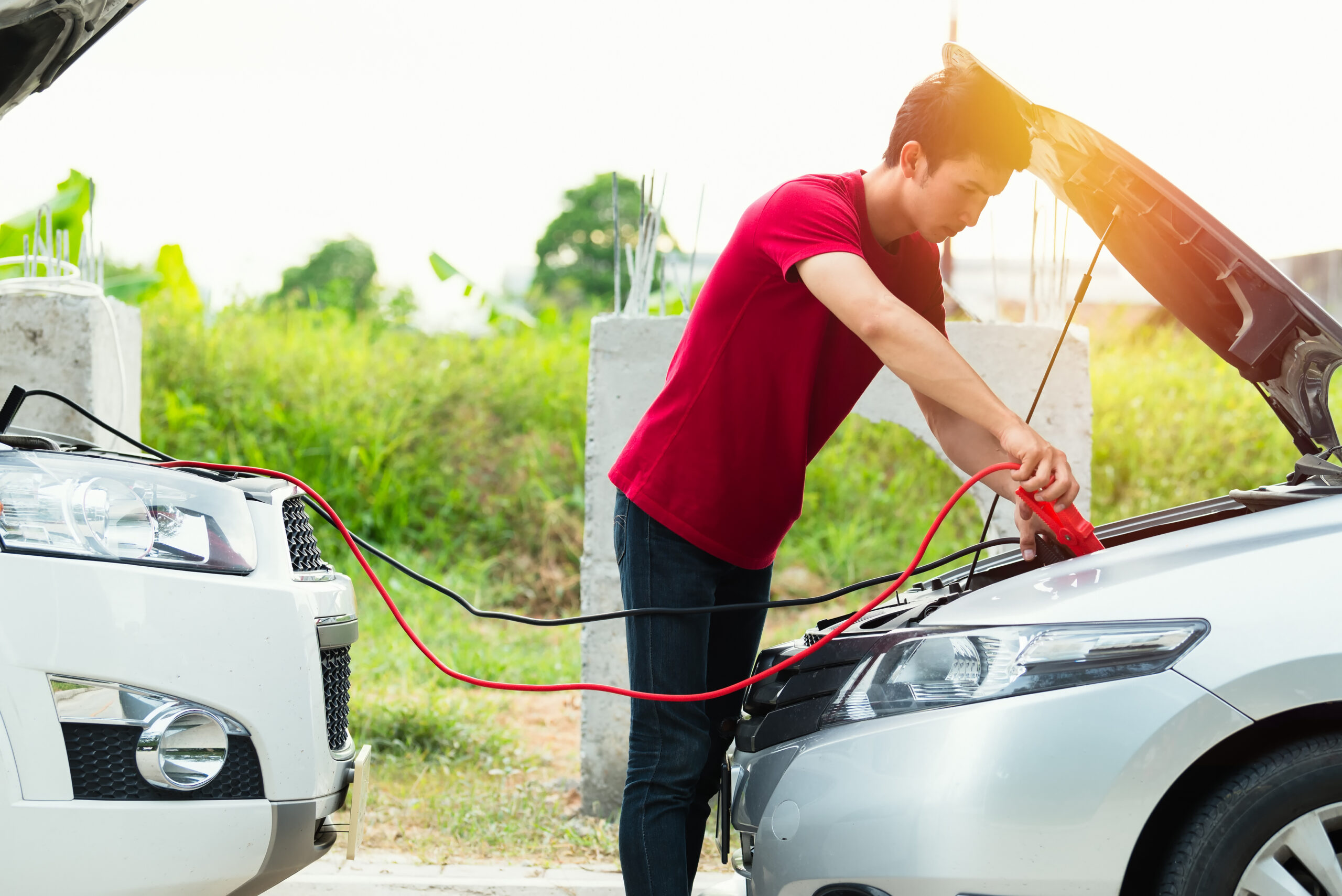A flat tire or a dead battery can turn a quick drive into a stressful situation. With a little instruction and preparation, you can handle these situations calmly and get back on the road quickly. This guide will equip you with the steps to changing a tire AND using jumper cables safely – the two most common roadside emergencies to date.
How to Change a Flat Tire
What You’ll Need:
- Spare tire
- Lug wrench (usually located in the trunk with the spare)
- Jack (also typically found in the trunk)
- Owner’s manual (consult this for specific instructions on jack placement for your car)
- Warning triangles (optional, but recommended for added safety on the roadside)
Steps:
- Park Safely. Find a level, solid surface away from traffic. If possible, pull onto the shoulder and activate your hazard lights. Engage the parking brake and put the car in park.
- Prepare the Spare. Locate the spare tire and lug wrench in your trunk. If your spare is not inflated, you might have a tire inflator kit in the trunk.
- Loosen the Lug Nuts. Use the lug wrench to loosen the lug nuts on the flat tire slightly (about a quarter turn) while the wheel is still on the ground. Don’t remove them completely yet.
- Position the Jack. Refer to your owner’s manual for the designated jack points on your car’s frame. These are typically reinforced areas meant to support the car’s weight safely. Carefully position the jack under the correct point closest to the flat tire.
- Raise the Car. Slowly and carefully raise the car with the jack until the flat tire is a few inches off the ground. Double-check that the car is stable and the jack is positioned securely.
- Remove the Lug Nuts. Now that the tire is lifted, remove the lug nuts completely and place them somewhere you won’t lose them.
- Replace the Flat Tire. Align the spare tire with the hub and slide it onto the bolts. Screw the lug nuts back on by hand as tightly as possible.
- Lower the Car. Slowly lower the car using the jack until the spare tire touches the ground firmly.
- Tighten the Lug Nuts. Once the spare tire is on the ground, use the wrench to tighten the lug nuts in a star pattern (tighten one nut, then move diagonally to the next, and so on). Ensure they are snug but not overtightened.
- Store the Flat Tire. Secure the flat tire in your trunk along with the lug wrench and jack.
- Get the Flat Tire Repaired. As soon as possible, have a qualified mechanic repair the flat tire to ensure it’s safe to use again.

Using Jumper Cables Safely
What You’ll Need:
- Jumper cables (ensure they are in good condition, with no cracks or frayed wires)
- Another vehicle with a functioning battery.
Steps:
- Park Safely. Park both vehicles on a level surface, away from traffic, with the parking brakes engaged and engines off. Make sure the vehicles aren’t touching.
- Neutral Gears. Ensure both cars are in park, and have their keys turned off completely.
- Identify Terminals. Locate the batteries in both vehicles. They’ll be covered by plastic casings with positive (+) and negative (-) terminals clearly marked, typically red for positive and black for negative.
- Connect the Positive Cable. Carefully connect the red clamp of the jumper cable to the positive terminal of the car with dead battery. Then, connect the other red clamp to the positive terminal of the helping car’s battery.
- Connect the Negative Cable. Locate a solid, unpainted metal grounding point away from the battery on the dead car (often on the engine block). Connect the black clamp of the jumper cable to this grounding point. Then, connect the other black clamp to the negative terminal of the helping car’s battery.
*Double-check all connections are secure and no cables are touching each other.*
- Start the Helping Car. Start the engine of the helping car and let it run for a few minutes.
- Start the Dead Car. Try starting the car with the dead battery. If it starts after a few seconds, you did it!
Disconnect in Reverse Order:
It’s important to disconnect the cables in the reverse order they were connected to avoid sparks. Never touch the two cable clamps together while connected to the batteries.
- Remove the black clamp from the grounding point on the dead car.
- Then, disconnect the black clamp from the negative terminal of the helping car’s battery.
- Next, remove the red clamp from the positive terminal of the helping car’s battery.
- Finally, disconnect the red clamp from the positive terminal of the dead car.
- Let the Dead Car Run. Allow the car with the jump-started battery to run for a few minutes to recharge its battery. Avoid revving the engine.
- If the Jump Doesn’t Work. If the car doesn’t start after several attempts, there might be a more serious issue with the battery or the car’s electrical system. It’s best to call for roadside assistance.
Free Roadside Assistance from the IDG
If you run into a dead battery or flat tire while on the road and end up needing a tow or professional assistance, the Independent Driver’s Guild has your back.
The IDG offers roadside assistance to rideshare drivers who sign up and become dues-paying members. The program offers drivers the following:
- Towing up to 10 miles
- Fuel delivery up to 5 gallons
- Lockout service
- Flat tire service
- Jump start service
- Battery replacement
- Glass replacement
- Accident assistance
To enroll and activate the IDG’s Roadside Assistance program, members can visit the website here.
If you are already a dues paying member and need help from your Roadside Assistance program while on the road, simply:
- Call 1-800-559-0097.
- Tell the operator you have roadside assistance.
- Give them your Plan – Letter B, your driver ID number (the number on your TLC license), and the following 6-digit producer code – 106736.
- If they ask for the date you enrolled, it is always the 1st of the month.




